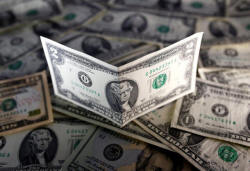|
Dollar surges to 11-month
high as bond rout persists
 Send a link to a friend
Send a link to a friend
 [November 14, 2016]
By Patrick Graham [November 14, 2016]
By Patrick Graham
LONDON
(Reuters) - The dollar surged to an 11-month high against a basket of
major currencies on Monday, resuming an upward track driven by U.S. bond
yields and expectations for higher inflation after Donald Trump's U.S.
election victory.
China’s yuan lost another third of a percent to fall to its weakest
since before the launch of its offshore market in 2010, while the yen
and the euro both sank by about another full percentage point to
multi-month lows.
Friday had seen a halt in the bond sell-off that has been the clearest
global reaction in markets to Trump's election, but U.S. 10-year yields
rose by another 11 basis points on Monday.
"I think people were just pausing for breath," Rabobank strategist Jane
Foley said.
"The rise higher in yields, coupled with the fact that people have been
reducing dollar longs for most of this year, has really played into
this. It is really setting the tone for all other markets."
The euro fell to $1.07285, its lowest since January, before steadying at
$1.0766, still leaving it down 0.9 percent on the day. The dollar index
<.DXY> rose 1 percent to 100.04, its highest since last December, before
also easing back slightly.

At the heart of the moves are expectations that Trump's administration
would both boost spending and put more restrictions on trade, both steps
that could put an end to the low inflation which has dominated the past
decade in the developed world.
The 10-year Treasury note yield <US10YT=RR> rose to a 10-month high of
2.3 percent in European trade.
The latest IMM report showed "long" bets on the dollar gaining had been
rebuilt over the past month but they still remain about half the levels
recorded during last year among asset managers and leveraged funds.
Analysts from one of the market's biggest dollar bulls in recent years,
Deutsche Bank, said they now felt confident the dollar would reach their
year-end target of $1.05 per euro.
"The dollar is approaching its sweet spot for a late-cycle rally,"
Deutsche strategist George Saravelos said. "When the dollar last broke
out of such a prolonged range corporate hedgers and asset allocators
were caught off guard and the euro moved 10 percent within the following
few weeks."
[to top of second column] |

U.S. dollar notes are seen in this November 7, 2016 picture
illustration. Picture taken November 7. REUTERS/Dado Ruvic/Illustration

Investors are still struggling to grasp all the implications the new
U.S. president may have for the world's economic balances. For the Bank
of Japan, so far, it has eased one of the major headaches: the global
pressure for a stronger yen.
Japanese third-quarter growth data also provided some encouragement,
expanding for a third consecutive quarter at an annualized rate of 2.2
percent.
"Sharply higher U.S. yields are providing an initial boost for USD/JPY
while concerns over more protectionist U.S. trade policies which would
favor a stronger yen are judged as less important for now," MUFG
currency analyst Lee Hardman said.
On China, for now, the market is choosing to simply bet on a falling
yuan - without necessarily reading across to what that may mean for real
prices, for instance, or for manufacturing goods and commodities or the
chances of large dollar debt defaults by Chinese companies.
"There is the issue of too much debt in China," Rabobank's Foley said.
"And then there is the issue of too much debt being owned in China.
Would one of the ways in which Beijing could retaliate (to U.S.
protectionism) be to sell U.S. Treasuries? And what would that do to
Trump's plans for taxes and spending? The market is choosing to ignore
that just now."
(Editing by Louise Ireland)
[© 2016 Thomson Reuters. All rights
reserved.] Copyright 2016 Reuters. All rights reserved. This material may not be published,
broadcast, rewritten or redistributed.
 |